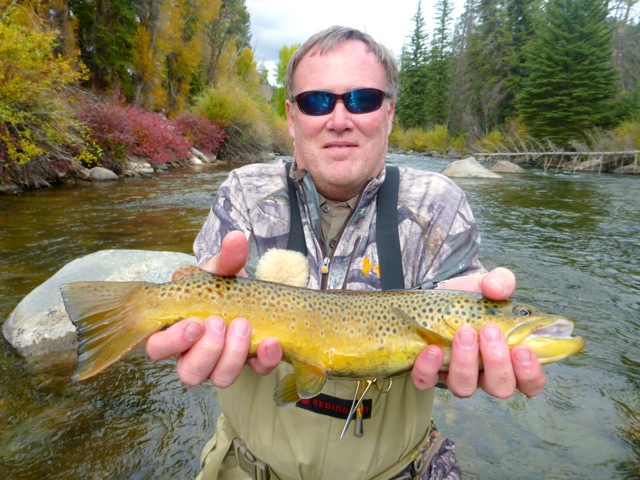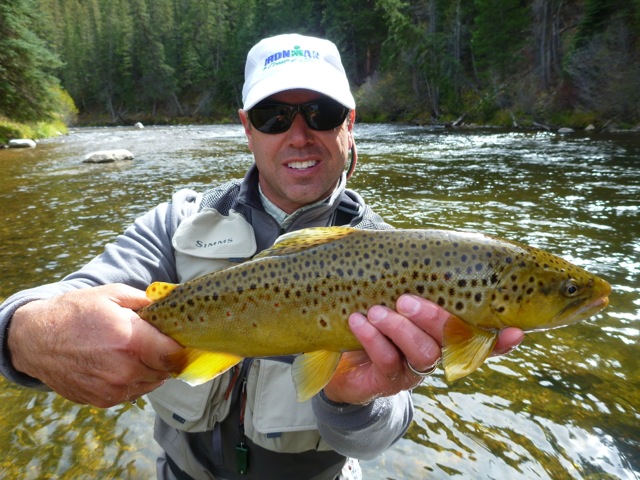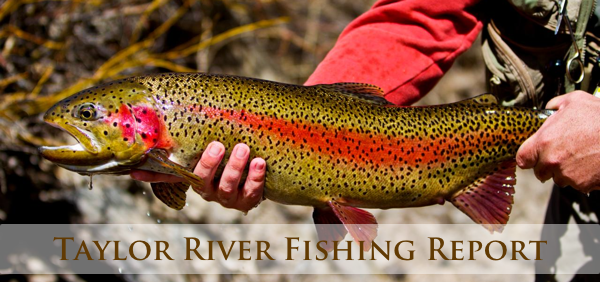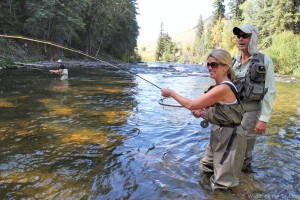By Lu Warner, Master Guide at Wilder on the Taylor
Well, it’s hard to imagine a better ending to a great season of fishing at the Wilder on the Taylor. As the river settles into the low flows of Fall and early winter, Mayflies and Midges are still hatching in big numbers, Fall Caddis are dancing on the water and fish are rising as well or better than they have all summer. This should continue until the icy grips of winter set in.
Mother Nature has been particularly good to us this past year as an above average snowpack and timely summer rainfalls have maintained the Taylor flows above the historical average and the fish are strong, healthy and extremely well fed. The recent drawdown of the dam at Taylor Reservoir has reduced the current flows at the Wilder to 240 CFS up about 25% from this time last year.
At this level you can literally see fish everywhere and with the wading being a bit easier with the lower water levels the fishing is incredible. Especially noticeable are the large female Brown Trout that huck themselves into the air in an attempt to loosen up their eggs before the upcoming spawn. It’s hard for 10 minutes to pass without seeing a big fish splash.
If you want to try to catch a trophy Brown Trout, this is the time to do it. Large Browns are getting territorial as they approach spawning and at times can be very aggressive to a well placed streamer. This is not a numbers game and one might have to cover a lot of water before luring one of these brutes into a strike. Pay attention to the very tail outs of the pools..in the shallow slicks..Recommended Streamers are: Egg Sucking Leech, Sculpzilla -Black and Olive, Olive Wooly Buggers.
Otherwise both Dry and Dry Dropper have been very effective. Mornings always start a bit slow on the Taylor because the water is so cold. A size 10 Bead Head Pheasant Tail or Hare’s Ears fished deep under a large dry in soft water can be deadly.
Around 10 a.m. things start to happen and huge clouds of Midges begin to hatch as the day warms. If you look in the stillest currents and thin foam lines, you can see larger fish slowly sipping these tiny midges and target them with a well placed Griffins Gnat or equivalent on 6X. This is exacting fishing and a slow stalk and gentle cast can yield surprisingly big fish.
Around 11 a.m., the Midges die off and lots of Mayfly Spinners lay their eggs and hit the water. The majority at this time of day are Mahogany Duns and a size 14-16 Rusty Spinner can be the ticket to any rising fish that you see. If nothing is doing on top, then tie on a size 10-14 Orange Stimulator and fish a #16 Pheasant Tail underneath it. The big Orange Stimulator looks exactly like the Fall Caddis that are hatching sporadically throughout the day. If a dead drift doesn’t bring up a fish, try to skate it a little and twitch a fish up. Many times the fish react better to the twitch than a dead drift.

Sometime around noon, Mayflies start to hatch and the fish start to rise consistently. Typically the best fly is a small Blue Winged Olive, however with a variety of Mayflies still hatching, many other patterns can work well. I suggest Mahogany Duns, Gray Drakes, Para Adams in different sizes depending on what you see on the water. Excellent dry fly fishing can continue right up until 5 p.m. or so. This is a good time of year to catch large Browns and Rainbows on small dries as they are fattening up before winter. Last week in one pool, I saw 4 Browns in the plus range sipping tiny Blue Wings very quietly. If you see a strong hatch, it is a good time to go to the deep, slow pools where large fish live and find one to fish to.
The best tip for fishing at this time of year is to move slowly and look carefully. There are fish everywhere but they are spooky. Long, light leaders and soft presentations are key. Many large fish can be sighted in shallow water and if you can get your fly to them without alarming them, the odds are high that you can catch them. Expect peak activity between 12 and 4 pm.
Rarick Creek has lots of big Browns and Rainbows that have not seen a fly in almost a month. These fish will move willingly to your fly and a good session out here will be sure to put a big smile on your face. While some fish will still eat Hoppers, a better call right now might be a smaller dry such as a Gray Drake and if needed a small dropper below.
The Ponds are full of very fat and very selective Rainbows and Browns. We have had the best luck with small leech patterns and damselfly nymphs. A long cast followed by a slow, twitchy retrieve seems to produce the best results. I find it best to sight fish here. Walking along the bank until you see a big fish and casting to it increases the odds that you will hook one. Walk slowly and cast your fly well in front of a cruising fish. If you try a few fish and none eat, change your fly and keep trying until you are successful.
Well, next week I’ll be heading to our place in Chile to join Antonia and Vicente until we return in April of 2015. We all want to thank everyone who came and fished, worked, wined and dined, laughed and spent time with us at the Wilder this season and hope that you enjoyed it as much as we did. For me it was a pleasure to spend quality time on quality water with lots of great people. Cheers!

The Wilder is a special place and we look forward to seeing you out there next Spring.
Keep your backcasts high!
Wilder on the Taylor River offers a unique opportunity to own private fly-fishing property along with a beautiful riverfront home. Click the links to learn more.










